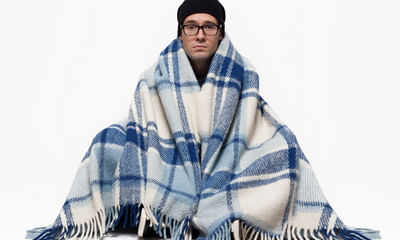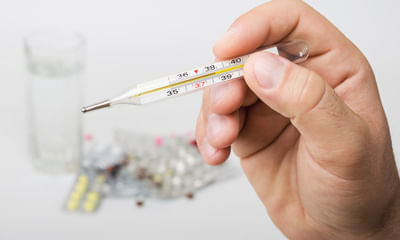Sudden Shaking And Chills
What are the symptoms of dengue and malaria? And where should he prevent to walk? ...
Ask Free Question
Common signs and symptoms of dengue fever include: High fever, possibly as high as 105°F (40°C) Pain behind the eyes and in the joints, muscles and/or bones. Severe headache. Rash over most of the body. Mild bleeding from the nose or gums. Bruising easily Common symptoms of malaria include: Shaking chills that can range from moderate to severe. High fever. Profuse sweating. Headache. Nausea. Vomiting. Diarrhea. Anemia.
How is flu caused what are its symptoms and what precautions should we take to prevent it from spreading. ...
Ask Free Question
Swine flu is caused by H1N1 virus and is more serious than normal seasonal flu.it is an air borne infection and spreads through the sneezing and coughing of infected individual Symptoms of Swine Flu 1.Fever, Cough 2.Nasal congestion, Sore throat 3.Headache, Myalgia,Fatigue,dyspnoea (Shortness of breath) 4.Vomiting, Diarrhea 5.Pneumonia and Respiratory failure(In Severe cases) Prevention of swine flu Avoid Over crowding places, contact with infected patient, use protective face mask, wash your hands frequently with sanitizers, Cover your mouth with tissue paper while coughing and sneezing etc
What are the symptoms of malaria. What are the symptoms of dengue fever. What are the symptoms of fever what shall I do. ...
Ask Free Question
Common symptoms of malaria include: shaking chills that can range from moderate to severe. High fever. Profuse sweating. Headache. Nausea. Vomiting. Diarrhea. Anemia. Symptoms of dengue fever sudden, high fever. Severe headaches. Pain behind the eyes. Severe joint and muscle pain. Fatigue. Nausea. Vomiting. Skin rash, which appears two to five days after the onset of fever.
What are the symptoms of malaria, what are the symptoms of dengue fever, what are the symptoms of flu what shall I do. ...
Ask Free Question
Hello, Malaria is an acute febrile illness. In a non-immune individual, symptoms appear 7 days or more (usually 10–15 days) after the infective mosquito bite. The first symptoms – fever, headache, chills and vomiting – may be mild and difficult to recognize as malaria. If not treated within 24 hours, P. falciparum malaria can progress to severe illness, often leading to death. Children with severe malaria frequently develop 1 or more of the following symptoms: severe anaemia, respiratory distress in relation to metabolic acidosis, or cerebral malaria. In adults, multi-organ involvement is also frequent. In malaria endemic areas, people may develop partial immunity, allowing asymptomatic infections to occur. Dengue: Dengue fever, also known as breakbone fever, is a mosquito-borne tropical disease caused by the dengue virus. Symptoms include fever, headache, muscle and joint pains, and a characteristic skin rash that is similar to measles. In a small proportion of cases, the disease develops into the life-threatening dengue hemorrhagic fever, resulting in bleeding, low levels of blood platelets and blood plasma leakage, or into dengue shock syndrome, where dangerously low blood pressure occurs. Flu or Influenza: Symptoms of influenza can start quite suddenly one to two days after infection. Usually the first symptoms are chills or a chilly sensation, but fever is also common early in the infection, with body temperatures ranging from 38 to 39 °C (approximately 100 to 103 °F). Many people are so ill that they are confined to bed for several days, with aches and pains throughout their bodies, which are worse in their backs and legs. Symptoms of influenza may include: Fever and extreme coldness (chills shivering, shaking (rigor)) Cough Nasal congestion Runny nose Sneezing Body aches, especially joints and throat Fatigue Headache Irritated, watering eyes Reddened eyes, skin (especially face), mouth, throat and nose Petechial rash In children, gastrointestinal symptoms such as diarrhea and abdominal pain, (may be severe in children with influenza B).
I want to ask about the symptoms of dengue and malaria, and the precautions we can take. ...
Ask Free Question
Symptoms of dengue are - sudden, high fever. Severe headaches. Pain behind the eyes. Severe joint and muscle pain. Fatigue. Nausea. Vomiting. Skin rash. Symptoms of malaria- shaking chills that are moderate to severe. High fever. Profuse sweating. Headache. Nausea. Vomiting. Anemia. Precautions in malaria and dengue are - to avoid mosquito bites. Keep home, environment and surrounding hygiene remove all stagnant water and containers keep all drains well maintained. Use mosquito repellents to avoid mosquito bite use mosquito screen to prevent mosquito attack use mosquito coils to kill mosquitoes wear long sleeve and fully covered clothes. Hope this helps you.
What are the symptoms of malaria and dengue and what are their precautions? Please tell? ...
Ask Free Question
Common symptoms of malaria include: shaking chills that are moderate to severe. High fever. Profuse sweating. Headache. Nausea. Vomiting. Diarrhea. Anemia. Symptoms of dengue fever sudden, high fever. Severe headaches. Pain behind the eyes. Severe joint and muscle pain. Fatigue. Nausea. Vomiting. Skin rash, which appears two to five days after the onset of fever. Stay indoors and prevent mosquito bites.
What is the reasons behind dengue and why it spreading. What are the symptoms of dengue and malaria. ...
Ask Free Question
Dengue fever is a disease caused by a family of viruses that are transmitted by mosquitoes. Symptoms include severe joint and muscle pain, swollen lymph nodes, headache, fever, exhaustion, and rash. The presence of fever, rash, and headache (the" dengue triad") is characteristic of dengue fever. Dengue is prevalent throughout the tropics and subtropics. Because dengue fever is caused by a virus, there is no specific medicine or antibiotic to treat it. For typical dengue fever, the treatment is directed toward relief of the symptoms (symptomatic treatment. Symptoms of dengue fever sudden, high fever. Severe headaches. Pain behind the eyes. Severe joint and muscle pain. Fatigue. Nausea. Vomiting. Skin rash, which appears two to five days after the onset of fever. Common symptoms of malaria include: shaking chills that are moderate to severe. High fever. Profuse sweating. Headache. Nausea. Vomiting. Diarrhea. Anemia.





